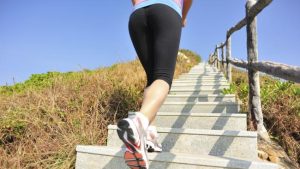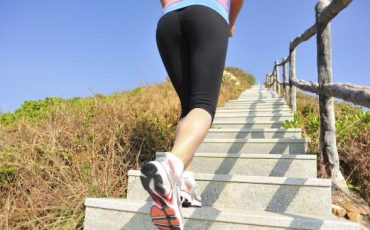Although many of you may be taking up a walking program to lose weight (and it is indeed effective with consistency), don’t starve your body for energy or forget to hydrate properly. Food is energy. It fuels your exercise, and that keeps you putting one foot in front of the other. That said, you won’t use more than about 50 to 100 calories per mile on a moderately brisk walk, so you don’t want to overdo the intake. If you plan to go for a walk at the end of the day, however, and if you haven’t eaten all day, you may end up feeling exhausted. Do yourself a favor and eat a small prewalk snack such as fruit, fresh or dried, or a few bites of a sports energy bar, or some other quality nibble. If you plan to head out for two hours or more, take a sports energy bar or fruit to keep you powered. Racers in different foot-powered activities may need up to 300 calories an hour at high intensities, but you’ll need less, albeit still some.
 When it comes to hydration, that’s an entirely different story. Everybody needs water and fluids. During exercise, you need about 6 to 16 ounces of water an hour, assuming it’s not particularly hot and you aren’t working out at a very high intensity. Normally, if you are going for 2 to 3 miles, you should be fine drinking a glass of water before you leave and swigging more when you return. However, if it’s extra humid or hot, err on the side of caution and carry water. If you plan to walk longer, always carry water. All kinds of water belts and packs are available, from those with reservoirs and drinking tubes to belts around your waist that hold bottles. Check out sporting goods, running specialty, or outdoor specialty stores to see which design best fits you and your needs.
When it comes to hydration, that’s an entirely different story. Everybody needs water and fluids. During exercise, you need about 6 to 16 ounces of water an hour, assuming it’s not particularly hot and you aren’t working out at a very high intensity. Normally, if you are going for 2 to 3 miles, you should be fine drinking a glass of water before you leave and swigging more when you return. However, if it’s extra humid or hot, err on the side of caution and carry water. If you plan to walk longer, always carry water. All kinds of water belts and packs are available, from those with reservoirs and drinking tubes to belts around your waist that hold bottles. Check out sporting goods, running specialty, or outdoor specialty stores to see which design best fits you and your needs.
What about sport drinks? Unless you’re out for more than an hour, you have no need to take in the extra calories; stick with water. If you’re going to walk longer or it’s very hot or humid, sip on a sport drink that isn’t too sweet and contains sodium and potassium.
Now that you have supportive shoes on your feet and appropriate clothing and other gear, it’s time to get technical. Let’s move on to training formulas, information about heart rate, stretching, and strengthening—information you’ll need before you can set out to make great strides.

Leave a Reply